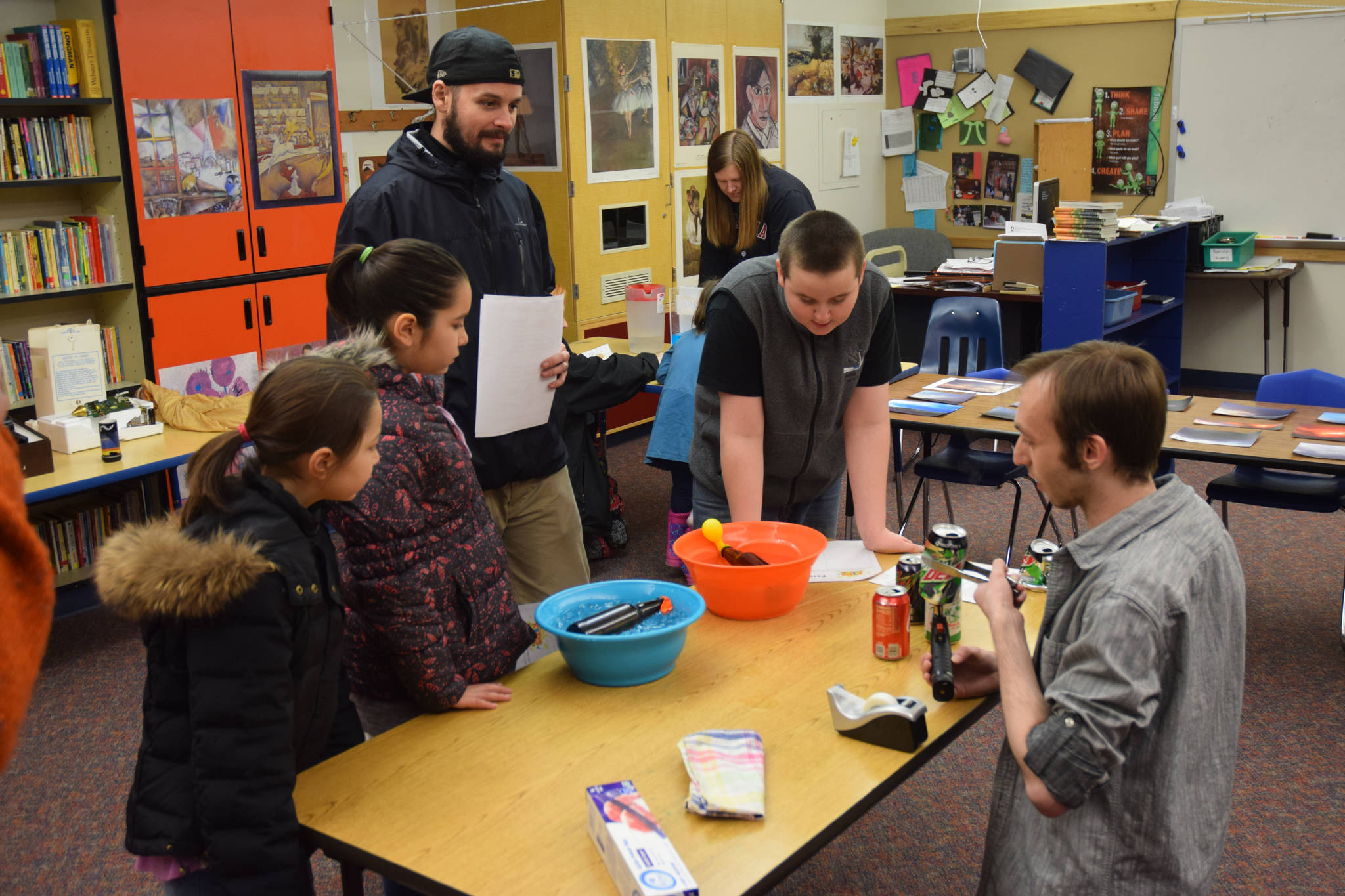Sharon Sullivan lit a match over a fishbowl filled with a few inches of green liquid at Harborview Elementary School on Thursday. Trying to be a good role model, she then dipped her hand in.
The National Weather Service meteorologist was demonstrating how heat and rising air currents work together at Science Night, a family event meant to stoke curiosity in science and science careers.
The fishbowl setup was meant to mimic a weather system. Hot smoke swirled above the liquid as Sullivan covered the vessel with an ice-filled bag, representing the cooler air found at cloud level. The bowl’s cold top and hotter bottom create a vortex of smoke, she explained. Hot air rises, so after the ice bag cools the smoke, it falls again toward the liquid, only to heat up again and rise.
Science outreach events like this one are important to get the next generation of lab-coat-wearing researchers, technicians and engineers started.
“Science Night is great because it just gets the younger kids involved,” she said.
It was events and mentoring available at events like these that gave Sullivan the meteorology bug at 8 years old. She went on to major in applied math, then onto meteorology in graduate school. Now she’s working for the National Weather Service office in Juneau.
Most of the sciences — including meteorology — are male-dominated fields, so it’s important to show girls that they too are represented in the sciences, Sullivan said.
At the elementary age, it’s crucial to stoke their natural curiosity, to encourage the inquisitive scientist in each student. Interest translates to hard work in any scientific discipline.
“They don’t have to learn a lot about science but if they just get that interest and find something exciting, they can apply it to other fields,” Sullivan said. “It’s just getting that interest and seeing others of us, like women and young people, it’s just like ‘Oh, they can do science, I can do that, too.’”
“We’re not all guys and we’re not all in lab coats,” Sullivan’s blowtorch-wielding colleague Jacob Byrd added.
Promoting STEM
Now in its second year, Harborview teachers and Science Night organizers Jennifer Thompson and Jessica Curry said the whole event started to promote science in the community. Science, technology, engineering and mathematics (STEM) jobs are the wave of the future, and really, the present, for students nationwide and around the world. To highlight the diversity of what’s available in STEM careers, Thompson and Curry network with engineers, scientists and naturalists through the Juneau STEM Coalition.
They then invite scientists to each take over a classroom, turning it into a mini-laboratory for the night. Harborview emphasizes collaboration and critical thinking, Curry said, which the scientific process uses in spades, so everything taught in the classrooms can be applied to other disciplines.
“We talk a lot about problem-solving and working together and collaborating. So using those skills and strategies at an early age are going to allow them to move on to careers that need all of those in order to be successful,” Curry said.
“I think it opens teachers’ eyes as well,” Thompson added. “What are STEM careers and what’s possible? Inviting them to meet scientists, it’s like ‘Wow, you can do this.’”
A school and laboratory
Down the hall from the NWS exhibit, Douglas Island Pink and Chum Macauley hatchery held their ever-popular touch tank and demonstrated Archimedes Principle — one of the guiding concepts of water displacement — through a crafting activity.
Juneau teacher Linda Torgeson taught students about reptiles in one room, while students worked with circuits in another room and played with chemistry in a third.
Across the way from the DIPAC room, retired National Oceanic and Atmospheric Association scientist Pat Harris taught students about water bears, a curious, microscopic and practically immortal creature also known as a tardigrade. (Did you know: there are over 1,100 species of water bear? They live everywhere from Antarctica to the North Pole and can even survive in the vacuum of space.)
Harris learned about water bears in a high school retreat. She explained how they’re able to survive in space.
“They go into this kind of cryo-state, where they can desiccate themselves,” and remove all their water, Harris said. “Then when water is around, they come back to life.”
A young man looked up from a microscope and posed a question.
“Excuse me? Are there any woolly bear in here? I mean, any water bear?” he said.
“I don’t know,” Harris said. “You’ll have to find them.”
• Contact reporter Kevin Gullufsen at 523-2228 or kevin.gullufsen@juneauempire.com. Follow him on Twitter at @KevinGullufsen.

